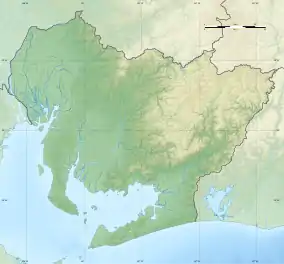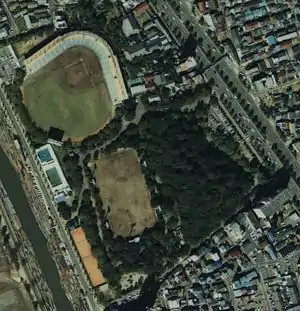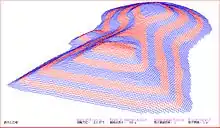Danpusan Kofun
Dampusan Kofun (断夫山古墳) is a large keyhole-shaped kofun burial mound located within the grounds of the Atsuta Shrine complex in Atsuta-ku, Nagoya, Japan. The site was designated a National Historic Site of Japan in 1987.[1]
断夫山古墳 | |
 Dampusan Kofun Kofun  Danpusan Kofun (Japan) | |
| Location | Atsuta-ku, Nagoya, Japan |
|---|---|
| Region | Tōkai region |
| Coordinates | 35°07′51″N 136°54′11″E |
| Type | kofun |
| History | |
| Founded | 6th century AD |
| Periods | Kofun |
| Site notes | |
| Ownership | National Historic Site |
| Public access | No |


Overview
The largest keyhole-shaped kofun in the Tōkai region of Japan, the Dampusan Kofun dates from the early 6th century. The burial mound has a total length of 151 meters, with the circular portion containing the burial chamber having a diameter of 80 meters, and a height of 16.2 meters. The 116-meter rectangular portion is terraced into three tiers, from which numerous fragments of cylindrical haniwa and Sue ware pottery have been recovered. Many of these artifacts are currently preserved at the Anthropological Museum of Nanzan University.
The presence of a large number of rounded river boulders indicates that the surface may have originally been paved with stones (fukiishi). The tomb was originally surrounded by at least one moat which can clearly been seen in the Meiji period maps, but the urbanization of the surrounding area in the post-World War II era has obliterated most traces.
The interior of the burial mound has not been excavated by modern methods. The name or rank of the person buried in the tomb is unknown. Per legend, the inhabitant of the tomb is Miyazuhime, the wife of Prince Yamato Takeru, whose purported grave is located nearby. Another theory is that the tomb is that of a powerful chieftain of the Owari clan, perhaps the Owari no Kusaka, who is mentioned in the Kojiki and Nihon Shoki chronicles of the Nara period, and whose daughter married the semi-legendary Emperor Keitai.
The Dampusan Kofun was under the management of Atsuta Shrine until World War II. After the war, it came under the control of Nagoya city until 1980, when it was taken over by the Aichi Prefectural government.
References
- "断夫山古墳" (in Japanese). Agency for Cultural Affairs.
External links
![]() Media related to Danpusan kofun at Wikimedia Commons
Media related to Danpusan kofun at Wikimedia Commons
- Atsuta Jingu park home page (in Japanese)
- Aichi Cultural Properties Navi(in Japanese)
